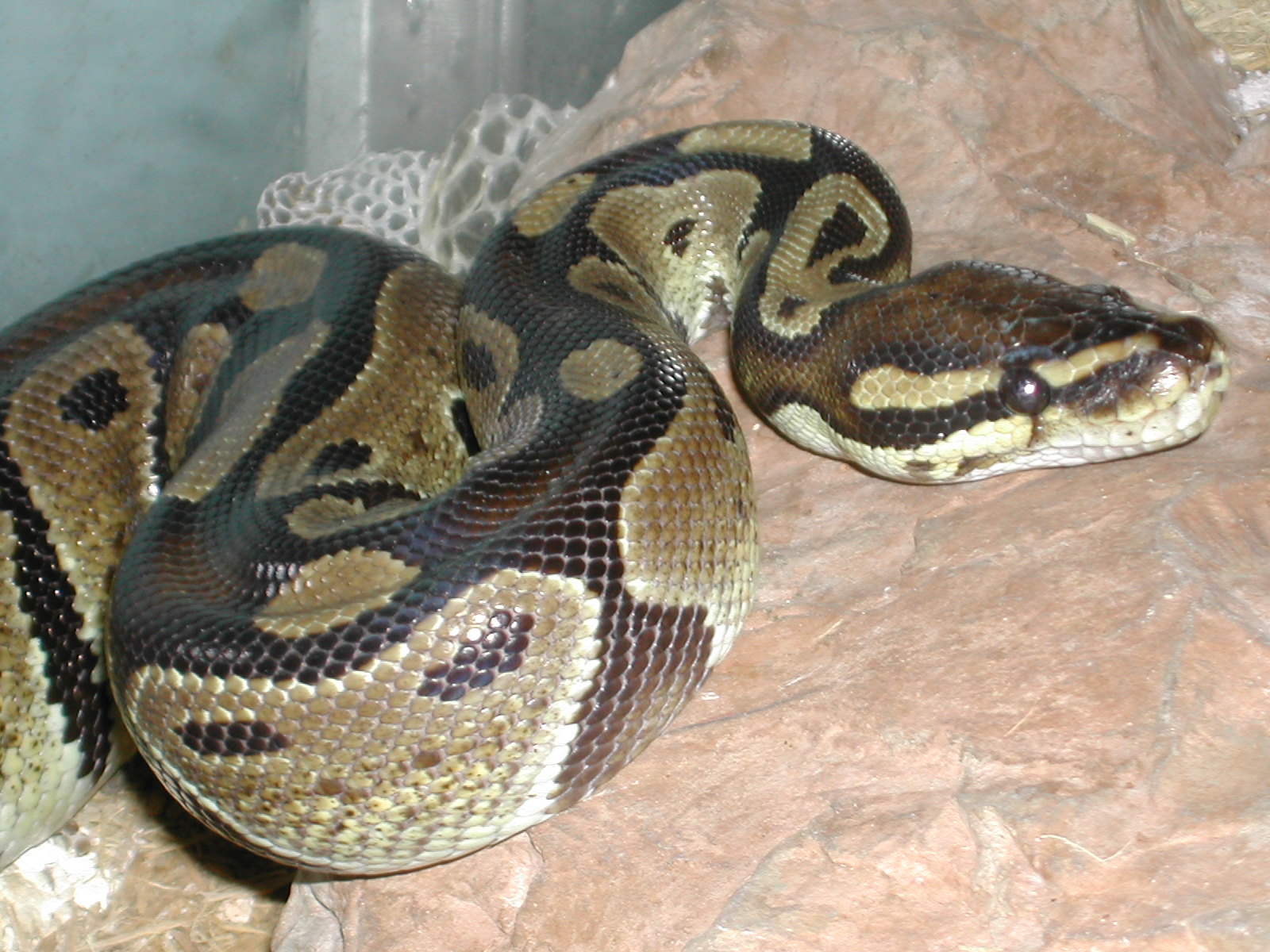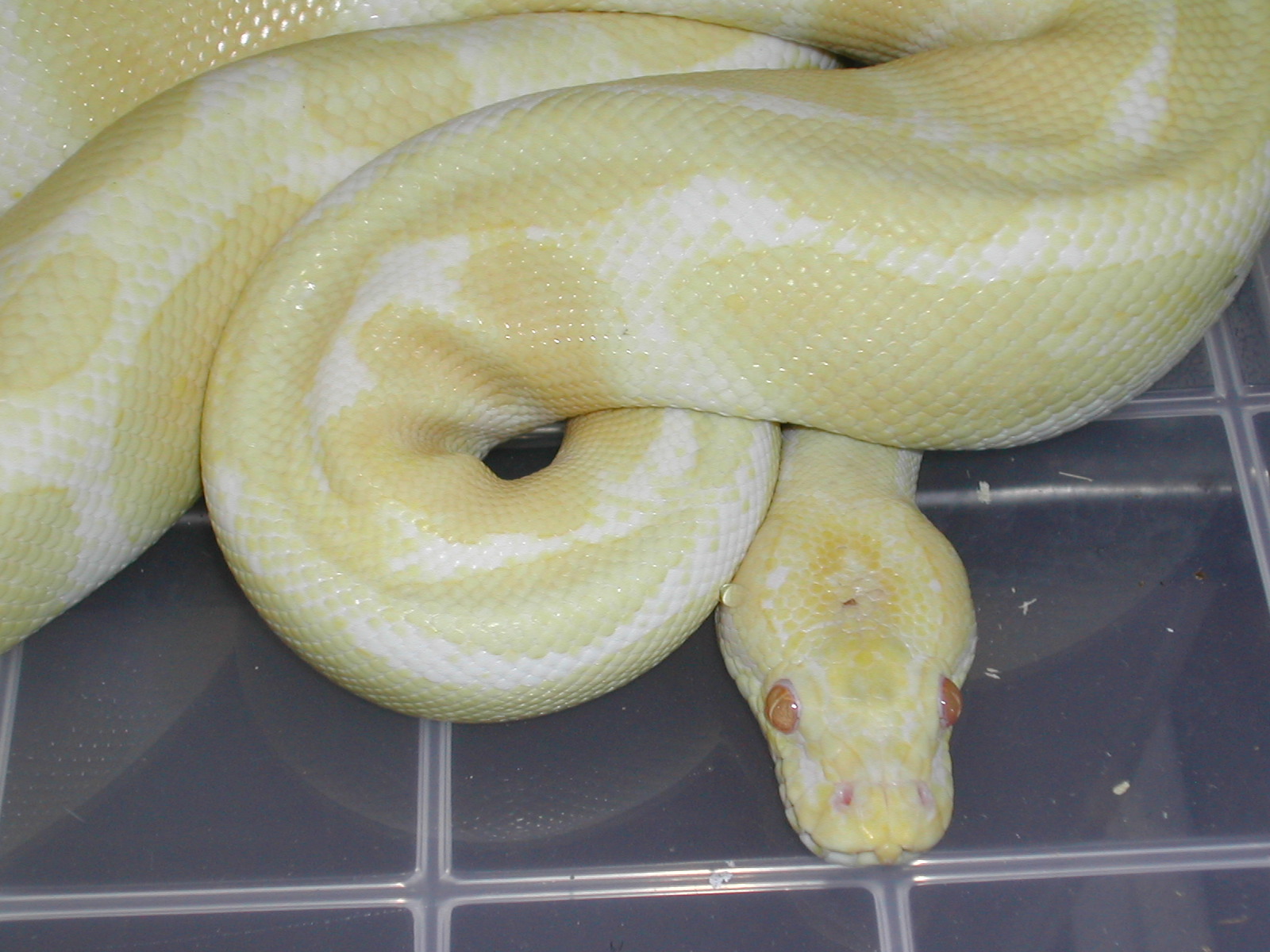|
Care of your Ball Python

Hatchlings- Obtaining your baby Ball Python from the right source can make all the difference in the world in this case. Many novice snake owners fall victim to purchasing a snake based on it's price. The lower priced Ball Pythons that are common in many conventional pet stores are often imported from Africa, hatchlings produced from eggs laid by wild caught females that are themselves destined for the pet market. Often, these snakes are simply off to a bad start, exposed to parasites and less than ideal temperatures, shipped overseas by the thousands in shipping containers, missing their opportunity to eat their first meals, etc. Sadly, many will never recover from this experience, especially those that end up in the hands of a novice keeper that is unprepared for a dehydrated and weakened hatchling that refuses to eat. The truely captive bred hatchlings of Ball Pythons, however, are generally hardy and easy to care for. Many dedicated breeders are now producing healthy babies that are well started and free of the problems that were once common with Ball Pythons. Additionally, many color morphs are being created through selective breeding and many new variants are available. Healthy hatchlings feed regularly on appropriately sized rodents (in this case, 5 to 8 day old mice). The right size food item is often a little larger than the snakes own head and the snakes ability to disengage its jawbones and stretch around the prey item allows the snake to accomplish an amazing eating feat. Some people may choose to provide a vitamin and mineral supplement that can be added to the prey item just prior to feeding, but some snakes (particularly young ones) will refuse the prey if it smells unfamiliar. Dusting only the rear end of the mouse and not the head may be acceptable to many snakes. It may not be necessary to add supplements to a snakes diet of rodents, but I have definitely had better breeding performance from snakes that have been supplemented. Hatchlings may be fed twice a week for the first few months to get a good body weight initially, but then cut it back to once weekly. Keep a small water bowl available at all times for baby snakes and be sure to keep it clean.
If you are having problems feeding your Ball Python, there are a number of "tricks" to get it feeding again. Try placing the snake in a paper bag (inside it's regular cage) with the prey item. If you are using pre-killed frozen foods, try warming the nose of the mouse against a light bulb and "teasing" the snake with it on the end of long foreceps. Alternatively, try a live mouse for a few feedings. These tricks attempt to elicit a feeding response based on the pythons heat sensitive facial pits that can be seen along the upper "lip" of the snake. Also, feed your snake at night or leave the mouse in with the snake overnight as long as the mouse is not old enough to injure your snake (i.e. it's jaws are not developed). My final suggestion here is to try a different prey item. African soft furred "rats" are a good alternative to the usual mice and rats. Some have also successfully "jump started" reluctant feeders with a gerbil. Transition your snake back to mice or rats quickly, however, so your snake doesn't key in on gerbils for all it's meals.
Adults- The adults are maintained in much the same way. Using a larger prey item, feedings can be scaled back to every 7 to 10 days throughout the warmer months of the year. Provide an adequate hide box where the snake will feel secure. Larger glass aquariums are not recommended, as the snake will feel too exposed to perceived "dangers" and likely will refuse to eat.
 General- The Ball Python is a smaller python, rarely exceeding 5 feet in length. Most of these snakes come from or originate from Ghana and Togo, Africa. They are largely a nocturnal snake, most active at night, passing the daytime hours in a secure retreat. If you must use glass aquariums, a 10-gallon tank will comfortably house a baby to juvenile snake, but an adult will need more space. A 40-gallon "breeder" tank (because it has a nice amount of floor space for your snake), or caging with similar space to it is more appropriate for an adult snake. In general, the snake should be able to fully stretch out along the longest side of the tank. The plastic shoe or sweater boxes utilized in rack systems for hatchlings or juveniles is acceptable and is easy to keep sanitary. Paper towels or newspaper make cleaning quick and easy and eliminates the possibility of ingesting any substrate. We use and recommend a shredded cypress bedding for babies and adults alike, as it is absorbent, easy to spot clean, holds the right amount of humidity, and is relatively cost effective. Adding some rocks, branches, and small plants (live or plastic) will make an interesting landscape for your snake to explore and add something for the snake to rub against when it has grown and needs to shed its skin. Providing an area where they can hide, such as a rock shelter or hide-box is essential and it is best to place one on the cool end of the tank and one on the warm end. Keep a heat pad, controlled by a thermostat, available at all times on the warm end of the tank. Proper heating is essential to digestion and the snake should have access to an area that is in the range of 86 to 94 degrees. Lighting is a matter of personal choice as the snake is nocturnal and doesn’t need to be too fancy since the snakes don’t seem to care, just be sure your snake always has access to shelter from the light and heat if they so choose. A red or blue nocturnal bulb used at night will enable you to check out your snakes night time activities without disturbing him. Put the lights on a timer to give the snake a sense of a day time and a night time, 12 hours on and 12 hours off for daylight lighting. Lastly, make certain the cage you keep your snake in has a tight fitting, escape proof cover. Use cage cover clips if you have a screen cover. Any means of escape will be discovered by the snake. General- The Ball Python is a smaller python, rarely exceeding 5 feet in length. Most of these snakes come from or originate from Ghana and Togo, Africa. They are largely a nocturnal snake, most active at night, passing the daytime hours in a secure retreat. If you must use glass aquariums, a 10-gallon tank will comfortably house a baby to juvenile snake, but an adult will need more space. A 40-gallon "breeder" tank (because it has a nice amount of floor space for your snake), or caging with similar space to it is more appropriate for an adult snake. In general, the snake should be able to fully stretch out along the longest side of the tank. The plastic shoe or sweater boxes utilized in rack systems for hatchlings or juveniles is acceptable and is easy to keep sanitary. Paper towels or newspaper make cleaning quick and easy and eliminates the possibility of ingesting any substrate. We use and recommend a shredded cypress bedding for babies and adults alike, as it is absorbent, easy to spot clean, holds the right amount of humidity, and is relatively cost effective. Adding some rocks, branches, and small plants (live or plastic) will make an interesting landscape for your snake to explore and add something for the snake to rub against when it has grown and needs to shed its skin. Providing an area where they can hide, such as a rock shelter or hide-box is essential and it is best to place one on the cool end of the tank and one on the warm end. Keep a heat pad, controlled by a thermostat, available at all times on the warm end of the tank. Proper heating is essential to digestion and the snake should have access to an area that is in the range of 86 to 94 degrees. Lighting is a matter of personal choice as the snake is nocturnal and doesn’t need to be too fancy since the snakes don’t seem to care, just be sure your snake always has access to shelter from the light and heat if they so choose. A red or blue nocturnal bulb used at night will enable you to check out your snakes night time activities without disturbing him. Put the lights on a timer to give the snake a sense of a day time and a night time, 12 hours on and 12 hours off for daylight lighting. Lastly, make certain the cage you keep your snake in has a tight fitting, escape proof cover. Use cage cover clips if you have a screen cover. Any means of escape will be discovered by the snake.
Other Helpful Info:
Þ Always buy a healthy captive bred animal and learn as much as you can from the source that you are buying it from, such as age, sex, what is it eating, etc.
Þ Find a local veterinarian who is knowledgeable about reptiles before any problems arise!
Þ Buy a good book about Ball Pythons or at least a book with a decent section about these animals and keep it on hand for reference. This care sheet contains only initial information to get you started and is by no means complete.
Þ Enjoy your Ball Python! These are fun and interesting pets.
|